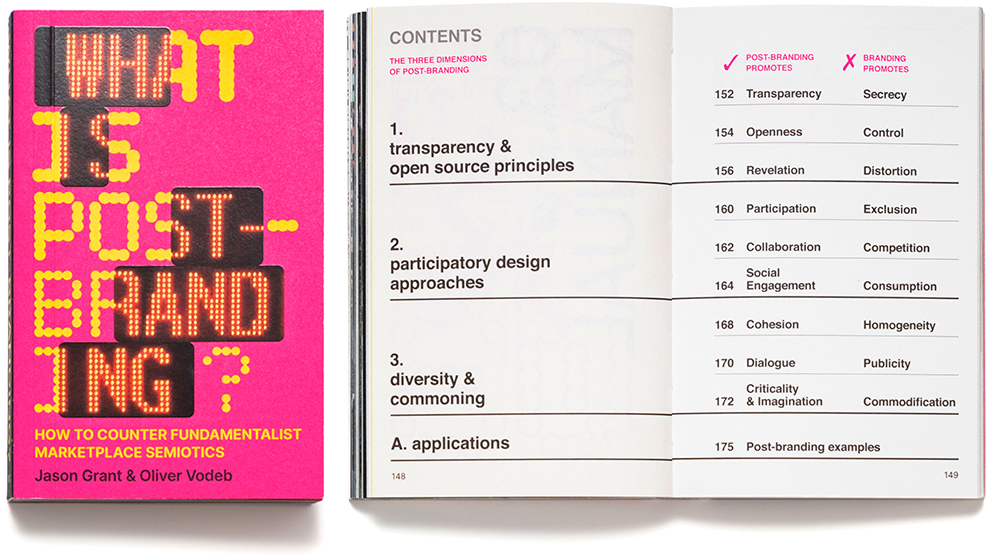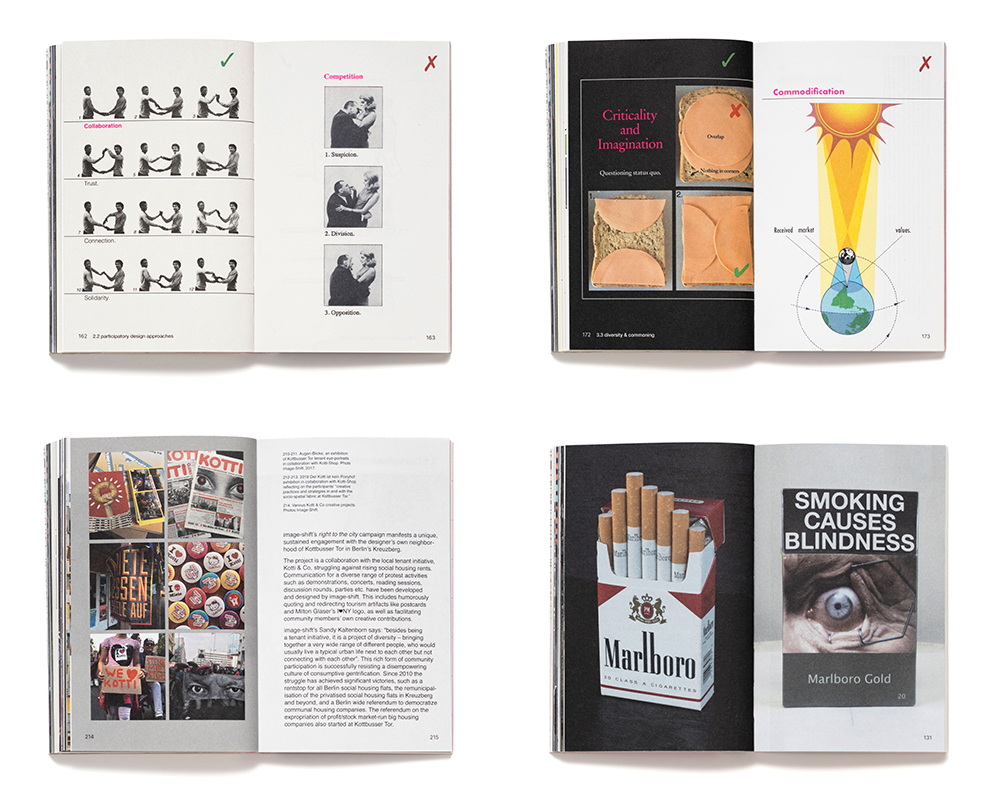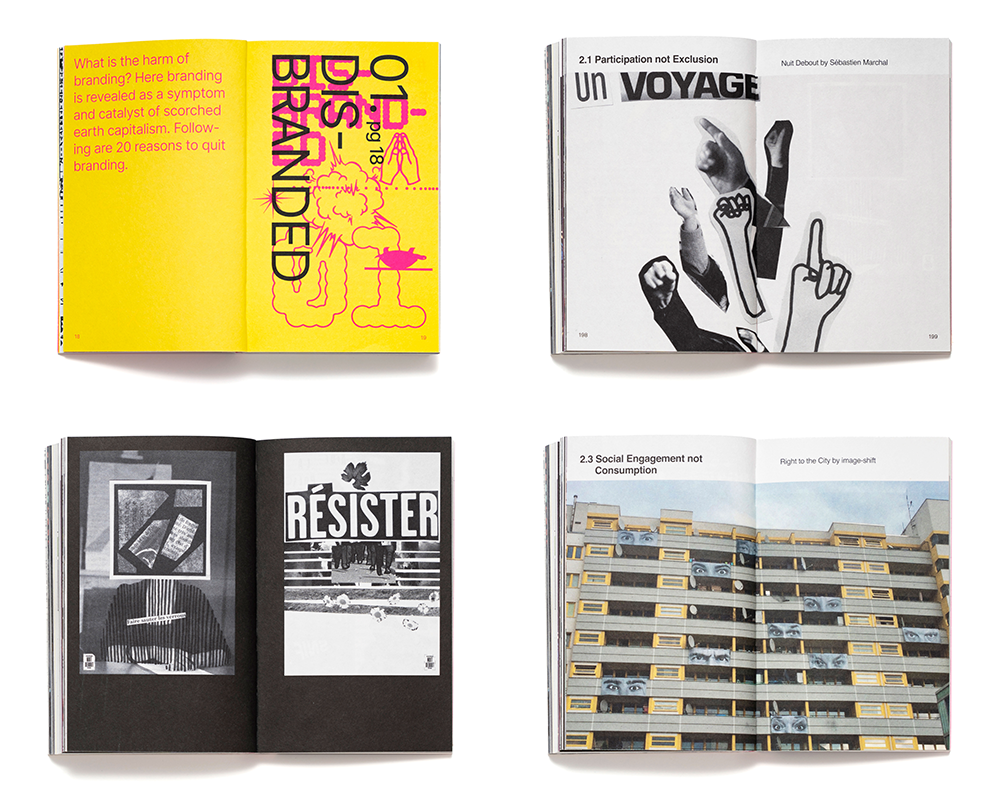
In their book, What is Post-Branding: How to Counter Fundamentalist Marketplace Semiotics, Jason Grant and Oliver Vodeb deliver a forensic take-down of contemporary branding practise. They align branding with a host of modern social ills: class division, rapid gentrification, exploitation of labor, and the arsenal of digital tools used to enforce marketplace dominance.
They write: “Branding has become an ideological Trojan horse, invading social and cultural realms traditionally resistant to corporate influence.” They identify a variety of offenders: ruthless corporations, advertisers, brand evangelists, the predatory strategies of Silicon Valley social media platforms, even the cult of personal branding is called out for its dehumanising effect. But it is design groups and banding agencies that are the targets for much of their occasionally savage critique.
Jason Grant is a graphic designer and co-founder of Inkahoots, an Australian design studio recognized for its work in “creative advocacy, activism and adventurous visual communication”. Oliver Vodeb describes himself as an “inter/extra-disciplinary designer, critical theorist, educator and student."
Their book begins with 20 aphoristic chapters offering a finely tuned analysis of branding’s insidious presence in modern life. The text fits snugly into the literature of anti-capitalist theorizing, and it’s not hard to conclude that the word branding could be replaced by “capitalism”, “marketing”, “advertising”, or “techno-utopianism”.

Their book is a welcome riposte to the guff that accompanies most branding rhetoric. The authors jab a finger at the impoverished, identikit language used by design groups and branding agencies, and what Grant calls their “uncritical swallowing of market ideology.”
A quiz titled "Guess the Branding Agency", offers a selection of agency declarations with the names of the perpetrators omitted and an invitation to the reader to name the culprits. For a sector that claims to be about creating difference, design groups and agencies do a good job at proclaiming their own lack of individuality.
Designers who are persuaded by the book’s central argument — branding is reductive and homogenising — will turn expectantly to the authors’ promise of a strategy to “counter fundamental marketplace semiotics”. Is there a way to practice the craft of giving services, products, and institutions a recognisable identity without the adoption of marketplace ideology?
The book offers the reader the three dimensions of post-branding. The first is transparency and open-source principles. The second is participatory design approaches. The third is diversity and commoning. In other words, it is a reversal of the top-down strategies of commercial branding.
The authors show a variety of examples of post-branding. These include the visual lexis devised for climate activists Extinction Rebellion, and Inkahoots’ participatory work for Burst Open, an exhibition about open-source design.

And here’s the problem: all the examples given are for social or activist concerns. How is the designer, faced with the task of making a living in the modern communication matrix, expected to survive if the only bodies willing to embrace post-branding are activist groups and not-for-profit entities?
Grant takes a hard-line approach. In an interview with Steven Heller, included in the book, he dismisses Heller’s observation that branding is “a neutral yet historical discipline” that can be used for “good or evil”. Grant replies: “I can't see any of this as neutral — unless you consider our social and economic systems as neutral. I think the communications industries are now so invested in branding there just doesn't appear to be a viable alternative — it's the ‘End of History’ for mass communication.”
A close reading of the book forces the conclusion that post-branding is not possible within the commercial world. Designers wishing to follow the path advocated by Grant and Vodeb have a stark choice: abandon commercial work or remain “invested” in a system that, to paraphrase the late Mark Fisher, is sustained by our inability to even imagine an alternative.
If What is Post-Branding doesn’t offer a blueprint for countering marketplace dogma, it at least provides a deft analysis of why one is not possible. The problem arises because of the gladiatorial nature of all commercial activity. Since countless products, services, and institutions have identical offers, branding becomes the principal tool — sometimes the only tool — to establish differentiation. As the authors state: “Branding is a product of competition and technology that sees the world as a never-ending race. The more competitive an organisation, the more it employs branding strategies.”
Editor's Note: The author replies, and herewith, offers some context for the book’s intentions.
We want to offer Adrian our deep gratitude for engaging with What is Post-Branding. His review gives a good outline of some of the book's main themes.
It also raises an objection that we agree is a valid concern, and yet is also a very regular way of dismissing critical alternatives:
"And here’s the problem: all the examples given are for social or activist concerns. How is the designer, faced with the task of making a living in the modern communication matrix, expected to survive if the only bodies willing to embrace post-branding are activist groups and not-for-profit entities?"The book, however, is actually framed primarily in response to the creeping scope of branding, as its blurb says: to "empower better design of public communication for civic and activist groups” — focusing on such groups for whom a conventional corporate branding methodology would contradict their values and undermine their mission. The examples we give, from activist, art and social spheres, intentionally omit commercial case studies in order to support the idea that non-commercial entities need not default to antithetical commercial communication techniques. These are organisations that don’t want their public communication to merely reproduce the self-defeating power relations embedded in capitalism.
There are already alternatives to branding, and although it's increasingly difficult to imagine, the market is not yet the whole world. We would also like to stress that our focus on civic groups covers a significant part of the economy, namely those entities which work towards the public good and serve civil society. These include NGO's and larger public sectors, such as health education, arts, government, housing and more. It is entirely possible for designers to make a living while working in these sectors.
In addition, there are already many for-profit companies taking their social and environmental responsibilities seriously who could (and actually already are) implementing post-branding principles (from our perspective) as a form of harm-reduction.
But if we can we zoom back for a moment? Branding is not inevitable, it's actually a relatively recent industry. Isn't framing the possibilities for design so narrowly part of the limiting of human potential itself? The market and its technologies deal in control and probability, not real freedom and possibility.
This isn't a just a posturing anti-capitalist rant, but a sincere attempt to limit the harms we do to each other and the natural environment we depend on.
Our concern is less for certain designers' pay packets, than adapting design for a viable tomorrow. Would a peace activist fret over a soldier's wage if there was an end to war? Aren't there a whole range of activities and professions that will need to be consigned to the past if we want any kind of decent future? If AI doesn't get there first, surely corporate branding, as a form of manipulative, exploitative and predatory design is one of them?
We appreciate Adrian paraphrasing Mark Fisher's “Capitalist Realism” as a defence of our thesis. In K-Punk Fisher writes: “What pop lacks now is the capacity for nihilation, for producing new potentials through the negation of what already exists,” He could have been writing about contemporary design?
We believe What is Post-Branding does indeed "offer a blueprint for countering marketplace dogma." It isn't intended as a final answer to the problem of branding, however, merely a pathway to new possibilities.
In the end we would like to thank Adrian again, his thoughtful critique is always welcome.
Jason Grant & Oliver Vodeb

